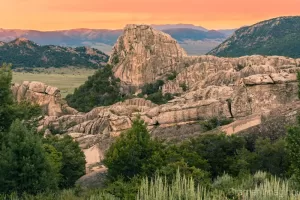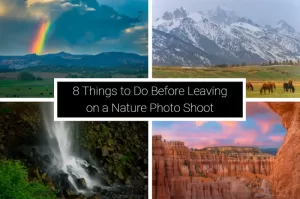The Importance of Safety in the Field
Shop

Safety when in the field is a fairly broad subject. You can safeguard your equipment and take some basic safety training for falls and first aid, but there are legitimate hazards in the field which are not just wild animals. Sometimes we have to deal with 2 legged aggressors as well. Here’s some basic advice on safety in the field and how to deal with these aggressive hazards.

Animal Aggressors
For animals, you have two basic worries: big animals and small animals. Yes, small animals can be a big concern particularly if you are in rattlesnake country. This means you must be prepared for them too. Remember to respect wildlife in the field or else said wildlife might become a threat. We’ll discuss both small and large animal threats.
Small Animal Threats
Starting with the smallest, you must worry about mosquitoes. While a mosquito bite isn’t a big deal, mosquitoes are now carrying nasty diseases in this area such as the West Nile and Zika viruses. Though neither West Nile nor Zika are as bad as we’ve been told, you still want to avoid getting bit so use repellent with DEET (the other stuff doesn’t work) or keep yourself covered. Also, avoid being outside at dusk and dawn as those times are when mosquitoes are most active.


Scorpions are another danger in some areas. Though they are prevalent in Idaho, I’ve never seen one in the field. Like snakes, unless you’re crawling around them, they generally won’t sting through your shoe. Simply be careful and shake out your shoes and clothing before putting them on if you camp. Also, check your bedding before sleeping as you will often find them hiding there too. Make sure to be careful around dark damp areas, like under logs, as scorpions hide in such places during the day and come out to feed at night.
Medium Animal Threats
Venomous snakes are another common danger in certain areas. Mostly around here the snake danger is solely rattlesnakes which generally warn you loudly before striking. Keep an eye where you step, and listen for their distinctive rattle. Do, however, be aware that rattlesnakes don’t rattle nearly as loud when wet. Also, if the snake received a recent injury and lost it’s rattles, it won’t rattle at all.
Being aware of of rattlesnakes, and their noises will go a long way toward helping you avoid them. Good hiking boots and gaiters also help a lot since snakes tend to bite where they can reach: namely your foot and lower leg. Protecting those parts of your body makes sense.



Most small to medium sized animals generally aren’t a threat. They avoid larger animals like humans and, while some are aggressive, they tend to not take on vastly larger predators such as people very often. The main danger they pose to us is rabies if they are mammals. If the animal is rabid, it will tend to act more friendly and may bite. While the bite itself is seldom more than painful, rabies is a really bad way to go. If you can’t capture the animal or at least kill it and preserve its head for medical examination, then you’re in for an unpleasant series of injections.
Large Animal Threats
Finally we get to large mammals. Bears, mountain lions, wolves etc are all fairly common in parts of the continental United States. Aggressive dogs can attack even when you aren’t trespassing. We had more than one neighbor, when I was young, with aggressive dogs who would often attack even when you were in the street. Each type of aggressive animal has different techniques, and wisdom passed down on how to deal with them. Often, such wisdom involves avoiding young, making loud noises, and appearing to be much bigger than you really are.



Human Aggressors

Of course four legged predators and aggressive mammals aren’t the only thing you may run across in the field. Safety in the field involves more than safety from wild animals. Sometimes you have to deal with aggressive or even predatory humans. The following is an example of one such encounter with a problematic human being.
Recently, photographer Alex Stone was doing some simple photography along a mostly deserted stretch of road in Ramona California when 52 year old Mark Dwayne Gordon drove up and insisted that the publicly maintained road was his driveway. When things got interesting, Mr Stone began recording the altercation.
You can see in the video below where Mr. Gordon attempted to run over Mr. Stone at least twice all the while demanding that Mr. Stone leave his driveway. Mr. Gordon, however, was doing everything he could to prevent Mr. Stone from actually getting to his equipment and leaving. Eventually Mr. Gordon slapped the phone out of Mr. Stone’s hand and broke the screen.

* Please note that you might not be able to see this video embedded here. YouTube may require you to go to their platform and meet age requirements to view it.
Mr. Stone called the police and, within a day or so, Mr Gordon was arrested for assault with a deadly weapon and held for $30,000 bond. Mr. Gordon was probably drunk and obviously belligerent. He clearly didn’t like photographers anywhere near his land and had a problematic sense of entitlement when it comes to what is clearly, and was confirmed by the local police, as public property.

The photographer did a pretty good of attempting to calm the situation, but ultimately failed. Most likely Mr. Gordon was in a state of mind and intoxication (and from the way he was slurring he was almost certainly intoxicated) which made encountering someone being polite all the more infuriating.
So what can you do in such a situation? The best course of action is to do exactly what the photographer did. Try to calm the situation as best as you can. If that doesn’t work, you may need to be prepared to properly defend yourself.
Having a camera capable of recording video is a big help. It gathers evidence and, though Mr. Gordon didn’t seem to be deterred, it will generally help some. A phone works for this purpose if it has video recording capabilities. A DSLR with video capabilities also works. Make sure your recording device of choice can get audio too.
Don’t be alone. Having witnesses will help deter belligerent and predatory individuals. If one or more of your “assistants” are large beefy individuals, so much the better. If you’re injured, your companions can help you. You can also have more than one person getting video of any altercations. Multiple angles can only help, and it means you have a better chance of retrieving video if, as in the above video, one of the recording devices receives damaged.

Companions can help when doing more dangerous photography as well. You’ve probably heard about the dangers of taking photos on railroad tracks. We obviously took this photo on some railroad tracks. We were safe in our quick venture because there were two of us: one to take the photos and the other to keep an eye and ear out for trains. At any time, we were ready to run off the side of the tracks for safety in the field.
We enjoyed relative safety because we were able to see several miles in each direction. We were also on a crossing which would require the engineer to blow the horn to announce his presence. However, we would have never considered this shot without a second person to do nothing but keep an eye for trains from the photographer’s blind side. After we finished the shot, we didn’t linger on the tracks for no reason. We left as fast as we could for our continued safety.
Don’t go hang out or play on railroad track for fun. It’s dangerous. Don’t take photos there either for the same reason.
What To Do

When it comes to safety in the field, there is absolutely nothing which beats training and preparedness. Carefully research out what hazards you might face and receive training in what to do for those situations. Get first aid training for all kinds of emergencies. Get rock climbing training for those activities. Also, get training in boating, swimming, and water rescues for water activities. Also, obtain training in wilderness survival if venturing out much past civilization for a long duration of time. The list goes on for trainings.
Carefully consider arming yourself. Arming oneself isn’t for everyone. It is a deeply personal decision. The idea of potentially needing to kill someone, and having the power to do so, isn’t something that some people can take.
If you don’t feel that you can do that, you probably shouldn’t carry a gun with you in the field. On the other hand, getting armed is a very efficient way to defend yourself against human and some of the smaller large mammals you may encounter in the field.
If you feel comfortable with it, obtaining firearms training and becoming armed is one of the most efficient ways to protect yourself that there is. Of course, you can’t legally carry weapons everywhere. Also, if you’re thinking of going up against a bear with only a pistol, you’ll live through a bad day at best.
Do bear in mind that most pistols aren’t sufficient for large mammals. The ones which are tend to be difficult for many people to use and control, particularly those who are of slighter frame and/or do not practice with them regularly.
Conclusion
When you go out, keep in mind where you are going. Check what kinds of hazards are there and put some thought into how you would address those specific hazards. Weather, animals, and even people can be serious hazards in the field and you need to do what you can to protect and defend yourself. Prepare and train for what you need to do and your efforts might just save your life in the field.
Have some other ideas of hazards in the field which we missed? How about tips for safety in the field? Add them in the comments section.
Best Sellers
Cramer Imaging Newsletter

Receive monthly updates in your inbox from us.





